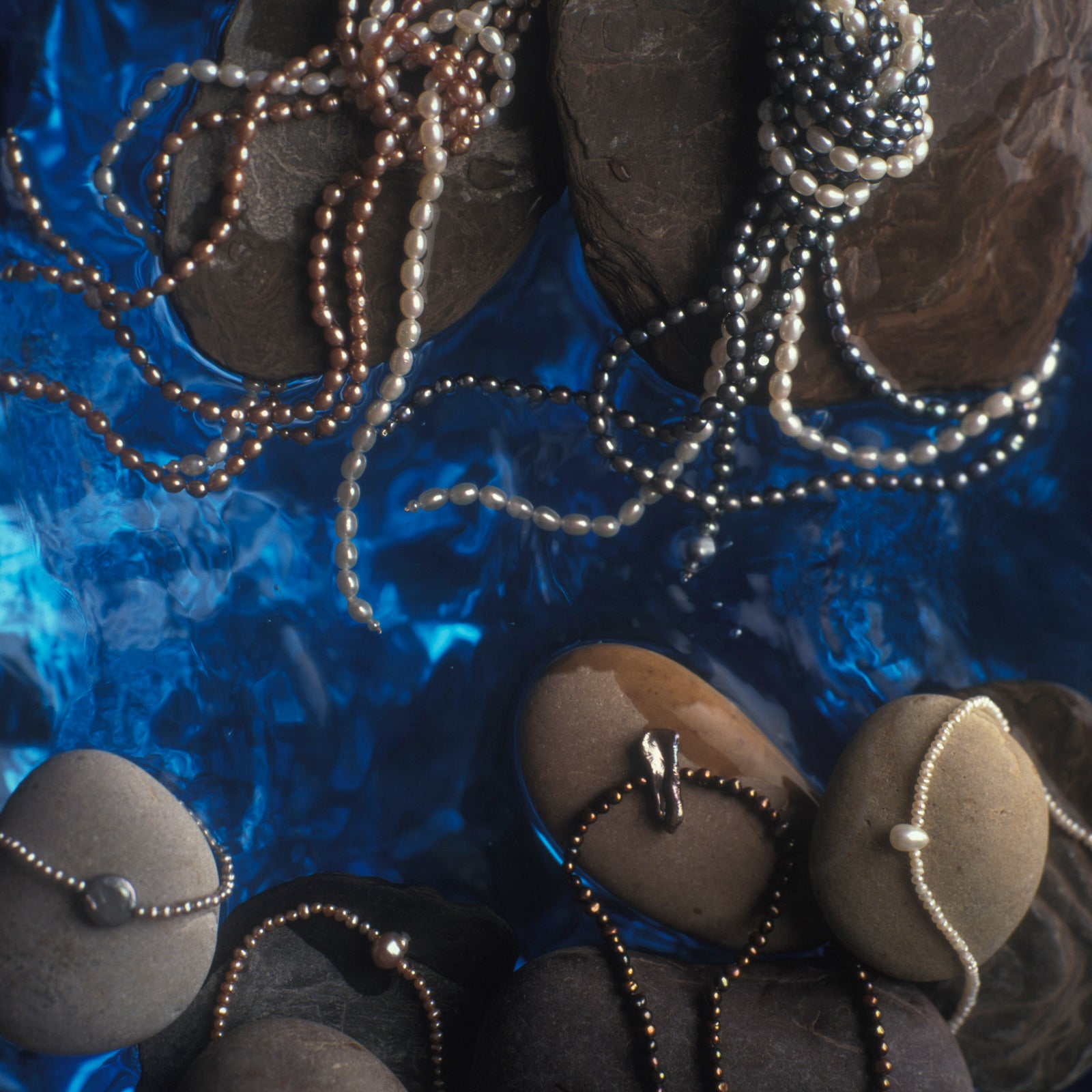
If you are new to the world of pearls, the choice of colours and types of pearls may feel a little overwhelming. We have therefore put together a definitive guide to help you tell the difference between each pearl type, from premium Akoyas to more subtle and affordable freshwater pearls. We’ve also included some suggestions on the kinds of occasions each pearl is best suited to, to help you get started and ensuring that browsing our pearl jewellery collection to find the perfect design is an enjoyable process.
Akoya pearls
Originating from the mild ocean bays of Japan, Akoya pearls are created within saltwater oysters known as Pinctada Fucata. These are the smallest pearl producing oysters in the world, generating just one elegant and fragile pearl throughout their lifetime.
Now found further afield in China, Vietnam and Thailand too, Akoya pearls are formed around a spherical resin or mother of pearl. This process takes around 18-24 months and gives the pearls their almost perfectly round shape, for which they are highly prized. However, their showstopping feature is definitely their lustre.
Despite typically being 6 - 9mm in diameter, Akoya pearls are very eye-catching due to their mirror-like surface which naturally reflects light for a glamourous golden glow. As such, luxury Akoya pearl necklaces offer a sense of timeless beauty that is perfect for red carpet events and formal dinners, especially when worn with complementary pearl earrings.
Available in a spectrum of shades, natural Akoya pearls range from pale blue grey to pale gold. They are most commonly found in the ‘pinked’ variety with white, gold or pink overtones.
If you’d like to learn more about Akoya Pearls, watch this video…
Biwa pearls
While cultured saltwater pearls date back to the 1910s, cultured freshwater pearls (which include Biwa pearls) came later. Inspired by the work of renowned pearl expert Mikimoto Kokochi, in 1928, Japanese entrepreneur Masayo Fusia tried to cultivate freshwater pearls at Lake Biwa.
Initially, his endeavour failed, as the nucleus beads inserted alongside the piece of epithelial tissue killed the freshwater mussels. However, Fusia eventually found that the pearls only required the tissue to form a pearl – not the bead.
Finally, he managed to culture colourful, lustrous Biwa pearls – the precursors to modern day freshwater pearls – which were highly sought after from the 1930s onwards. Unfortunately, by the end of the 1970s, Lake Biwa was becoming increasingly polluted and pearl cultivation was no longer viable there. As such, pearl production moved to China with the help of a group of Japanese technicians. Our own founder, Chrissie was mentored by the son of one of them!
Since relocating, Biwa pearls are now named as such for stylistic reasons. Thanks to their irregular shape, every Biwa pearl necklace, bracelet and earring set is entirely unique. Biwa pearls also provide a more organic finish than the perfectly round pearl, which creates a more natural, non-uniform jewellery style.
These petite, smooth pearls come in a range of hues like pink, peach, purple and grey, and they can also be treated or coloured to achieve bolder shades as required.
Freshwater pearls
Following the mainstream success of Biwa pearls, large scale pearl production began in 1970s China. During this time, the cultivation process was still being refined in a bid to make the mussels stronger and more resistant to illness. As a result, the pearls produced still lacked the smooth texture and rounded shape of saltwater pearls.
In fact, the market was saturated with crinkly ‘Rice Krispie’ and oddly shaped ‘Potato’ pearls, coined as such due to their appearance. The problem was that pearl farmers knew they couldn’t insert a manmade bead without killing the mussel, but the piece of natural tissue used as the irritant wasn’t giving them the desired result.
That was until someone tried harvesting a part-formed freshwater pearl, rounding it off on a machine and reintroducing it to the mussel to continue its formation. And voila! They created the beautiful, semi-spherical freshwater pearls that we know today!
Now, freshwater pearls are cultivated in slow moving rivers and lakes, and the majority continue to come from China. Each mussel produces anywhere from 6-120 pearls in its lifetime, with the pearl colour determined by the nacre of the shell, including white, cream, and pastel hues with a soft lustre.
The pearl’s own nacre is much thicker than that of saltwater pearls as there is no internal nucleus. As such, the denser material is more durable, meaning freshwater pearl jewellery is better suited to the rigours of everyday wear. Freshwater pearls are also much more affordable than Akoya pearls, given their abundance.
For the daytime, pair an elegant freshwater pearl necklace with a matching set of pearl stud earrings. Or elevate your look for the evening with a pair of drop style freshwater pearl earrings and an eye-catching pearl cuff bracelet.
Find your perfect pearls at Coleman Douglas Pearls
Whether you prefer the soft glow of freshwater pearls, the unmissable shine of luxury Akoya pearls or the quirky nature of stylish Biwa pearls, we have something to suit every taste in our versatile pearl collection.
If you can’t quite find what you’re looking for, we also offer a bespoke jewellery service which enables you to create your very own design. Simply tell us what you’d like and one of our talented pearl artisans will work with you to bring your idea to fruition, from the initial sketch to the actual stringing!
Alternatively, if you’re still undecided, visit our blog to discover more key differences between freshwater and saltwater pearls, as well as which pearl size is likely to suit your style and personality the best.



















